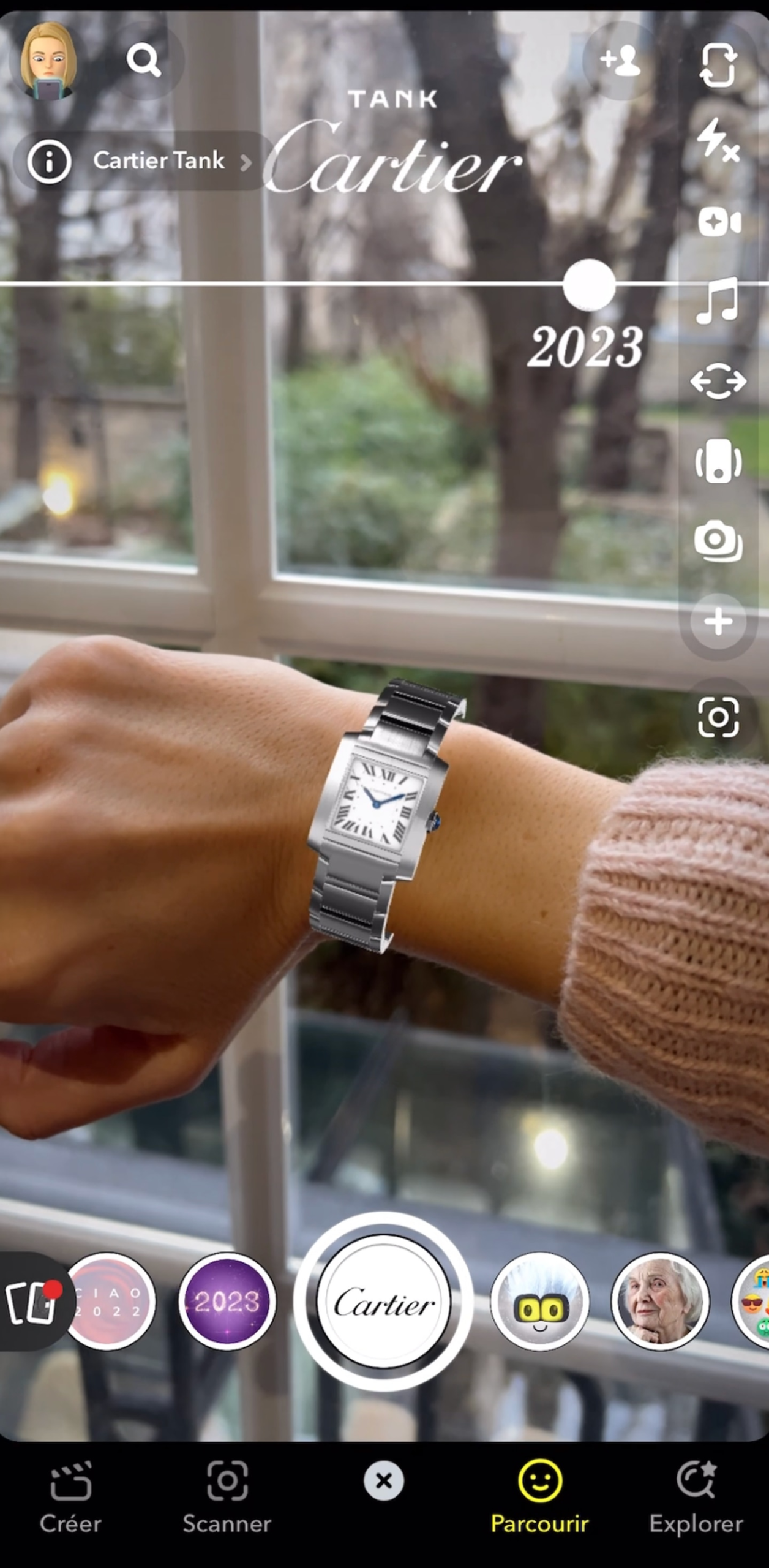
Cartier is getting into time travel.
The brand’s new campaign takes viewers through the history of its Tank watch, first designed by Louis Cartier in 1917, via augmented reality on Snapchat, where beginning today it will be promoted among the app’s featured Lenses.
The experience places you in 1917 on the Alexandre III bridge in Paris, amid a black-and-white landscape like an old photograph. Moving your phone around gives you a 360-degree view of the city suspended in time. Tap a point further down the bridge and you jump to 1936. Your surroundings are now in colour, the clothes and cars altered too. From there you can jump again to 1977 and finally 2023.
Cartier’s Tank watch, always hovering at the bottom of the screen, updates with each leap. When you reach the present, there’s a large, shiny version of the Tank Française, which the brand reissued last month, floating on the screen available for you to virtually try on.
Geoffrey Perez, head of luxury at Snapchat’s parent company, Snap, believes the campaign is an example of the way luxury can use AR for brand storytelling — and to drive sales.
“AR has become that amazing tool which has moved from being a toy, being very playful, to being very useful,” he said.
He only expects it to become more useful as the technology inevitably improves. At the moment, AR is still far from perfect. It can have difficulty mapping to a user’s body and its sensitivity to factors like the lighting in a user’s environment can make it glitchy at moments. AR objects also often look more cartoonish than realistic.
But it’s rapidly progressing as wireless internet speeds rise and smartphone cameras keep improving. Perez said just a few years ago, Snapchat wouldn’t have been able to offer an immersive experience like Cartier’s. Now, thanks to new capabilities like one it calls “ray tracing,” which more accurately captures how an object absorbs and reflects light, there’s more ability to get creative.
Even luxury brands with high standards for their imagery are dabbling in the technology, with virtual try-on the most eagerly explored use case. Brands such as Gucci and Dior employ it for categories like footwear and makeup. Last year, Farfetch went so far as to acquire Wanna, the company behind AR experiences like the virtual sneaker try-on in the Gucci app. The aim was to integrate it into Farfetch Platform Solutions, its e-commerce platform for brands and retailers, Farfetch’s chief executive, José Neves, said in an interview last year.
Neves and Perez both noted that AR can boost conversion rates for categories like sneakers, watches and beauty. One particularly strong example, according to Perez, was when Dior used virtual try-on on Snapchat to promote the launch of its B27 sneaker. It generated $6 in sales for every $1 in advertising spend, he said.
Whether Snapchat’s young audience will buy up Cartier watches costing thousands apiece after an AR try-on is arguably a different matter. Snapchat says there are other benefits though. Users who interact with a branded lens generally spend 10 seconds to 15 seconds with it, which is good engagement, and use of the technology is set to continue growing, according to a Deloitte survey last year commissioned by Snap.
While AR may shine when it comes to categories such as sneakers, jewellery and beauty, it has other shortcomings, however. Perez admits that apparel is “still a challenge.”
To make it work, Snap has to try to mimic the effects of gravity, which causes clothing in the real world to drape in a certain way, and then there’s the matter of fit. Every user’s body is different, so an AR version of an item has to try to take all of a body’s individual variations into account to approximate what it would look like when worn.
The company is working on it. Over time, Snap has introduced better body-tracking tools and in 2021 acquired Fit Analytics, a specialist in online sizing technology.
What should also help is the steady march of digital progress. It will take years for 5G wireless networks to roll out at scale, but once they do, internet speeds should be several times faster than they are at present. That would allow an AR asset to be several times larger than its current size without disrupting the experience. At the same time, phone cameras are set to keep improving, getting better at mapping objects in space and handling issues like low light. It could all make for AR that’s much more realistic.
The next step is to free it from a smartphone screen. Apple’s long-rumoured mixed-reality headset will supposedly be revealed this year. (Tim Cook, the company’s chief executive, has spoken openly about his belief in AR’s transformative potential.) Snap has its own AR glasses, called Spectacles, which it continues to develop. The hope is to remove what friction is left between the real world and the online world.



